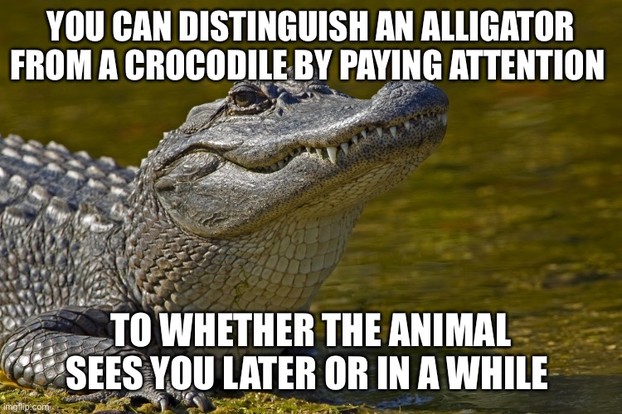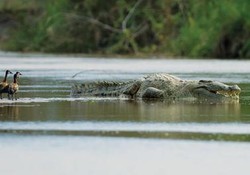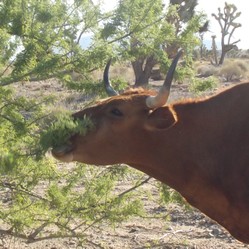A monstrously huge crocodile lives or lived in central Africa. Called Gustave, the reptile is of legendary proportions and seems to have a taste for human flesh. Attempts have been made to capture him, but Gustave is clever and likes his freedom. His story has been gathered from villagers in Burundi and may have been embellished over the years.

The Legend of Gustave the Man-Eating Crocodile
by RupertTaylor
A massive Nile crocodile is said to be responsible for the deaths of several hundred people.
 Corpulent Gustave basking on a rock |
Gustave's Home
The Ruzizi River is in central Africa. It flows from Lake Kivu in the north to Lake Tanganyika in the south; a distance of 72 miles (117 kilometres). On its western bank is the Democratic Republic of the Congo, on the eastern side are Rwanda and Burundi. At its southern end, the river spreads into a delta and it's here that Gustave lives, or lived.
He hasn't been seen for a while, leading to speculation that he may be dead, but he's a wily, old critter who knows his way around the many hiding places in his habitat.
He is thought to be more than 20 feet long. Only “thought to be” because nobody has been stupid enough to try to measure him from snout to tail tip. The same goes for his weight, estimated to be 2,000 pounds. As Nile crocodiles go, he's a Goliath. His age is guessed at as between 60 and 100, or dead.
He carries the disquieting title of the “world's most prolific serial killer,” with the frequently quoted number of victims of between 200 and 300.
Nile Crocodiles 101
The very thought of meeting up with a Nile crocodile sends shudders through us all. They are found in 26 countries in Africa and they are terrifying apex predators.
At the business end of the animal are between 64 and 68 sharp teeth set into jaws that can clamp shut with a crushing force of up 22,000 Newtons. For most of us that means nothing until we learn that a human bite can hit 150 Newtons at the top.
Once caught, there is very little chance of escape, so it's on to the stomach for digestion. For an animal that usually tips the scales as an adult at 1,500 pounds the Nile crocodile has a surprisingly small stomach—about the size of a basketball. However, that stomach is very efficient, containing acids that dissolve bones and hooves.
They are ambush hunters, often lurking under water by river banks, waiting for animals to come for a drink and then striking.
They have been recorded taking adult giraffes and even hippopotamuses. Larger animals are dragged underwater and drowned before being ripped apart for swallowing.
A human would be considered a snack, if crocs ate snacks, which they don't. Typically, a Nile crocodile will go weeks between meals.
Nile crocodile hunting technique
Meet Gustave
The central Africa area then, as now, was ravaged by turmoil and the people were hunting local animals for food. Soon, most of the local species were killed off. In addition, the bodies of many of the people killed in conflicts were thrown into the waterbodies and the crocodiles, being opportunistic feeders, said thank you very much.
It was 1987 when the first wanted posters went up for Gustave. This is when villagers living along the northern coast of Lake Tanganyika reported being attacked by a bigger-than-normal crocodile. The stories spread, some of them true, about this killing monster and zoologists travelled to the region to check out beast.
It wasn't until 2001 that expert Patrice Faye identified the illusive Gustave. He has been spotted many times since; there's no mistaking him because of his enormous size and the number of bullet scars he carries after failed attempts to kill him.
He also developed the reputation of being a thrill killer. This was because a number of partially eaten human remains had been found, leading local people to speculate that Gustave was killing people because he liked killing people.
Marc Gansuana is another crocodile expert. He told Newsweek, “They never kill for fun. Crocodiles have very few requirements in terms of quantity of food. Once killed, a prey item is not entirely consumed, except in very special circumstances. Thus, most of [Gustav's] prey—humans or cattle—were found almost whole, with only a few parts missing, which could explain why people thought it was killing for fun and not for food.”
In 2004, an expedition was mounted with the aim of capturing Gustave. A massive, baited cage was set up but the old reptile wasn't falling for that. Enormous snares caught only juvenile crocs. Eventually, brewing warfare forced the team to abandon their mission.
Writing for Forbes Magazine, Scott Travers notes that “This killer Nile crocodile’s last confirmed sighting was in 2009, and though reports surfaced in 2019 claiming he had been killed, no photographic evidence or carcass has ever been found.”
Perhaps, he's still lurking in the murky waters of the river waiting to strike.
Bonus Factoids
- Between 50,000 and 70,000 Nile crocodiles are believed to be currently alive and their species is not at risk. They are responsible for hundreds of human deaths in sub-Saharan Africa every year.
- According to the BBC, “Scientists have unearthed Australia's oldest known crocodile eggshells which may have belonged to 'drop crocs' - creatures that climbed trees to hunt prey below.”
- Crocodiles have undergone little evolutionary change for 100 million years and they survived the catastrophic events that wiped out the dinosaurs.
 It's all in the timing. |
Sources
- “What Happened to Gustave the Crocodile?” scienceinsights.org, September 30, 2025.
- “Nile Crocodile Facts.” factanimal.com, undated.
- “Giant Crocodile Said to Have Eaten 300 People: ‘They Never Kill for Fun.’ ” Pandora Dewan, Newsweek, December 9, 2022.
- “Gustave.” unresolved.me, undated.
- “Meet The World’s ‘Deadliest’ Crocodile—Linked to 300+ Human Deaths in the Longest Freshwater Lake on Earth.” Scott Travers, Forbes Magazine, February 20, 2025.
- “Evidence of Ancient Tree-Climbing 'Drop Crocs' Found in Australia.” Lana Lam, BBC, November 11, 2025.
© Copyright Rupert Taylor 2025
You might also like
The Mystery Predators of BritainOr Alien Big Cats. Wild cats that exist in countries where they are not usual...
Animals in the YardA glimpse of the Arizona desert wildlife and not so wild life, that I see fro...




 The Amazing English Language16 days ago
The Amazing English Language16 days ago
 When Donald Trump Came to Dinner17 days ago
When Donald Trump Came to Dinner17 days ago
 The Bleakness of Nihilism18 days ago
The Bleakness of Nihilism18 days ago
 The Double Life of Charles Kuralt20 days ago
The Double Life of Charles Kuralt20 days ago


Comments